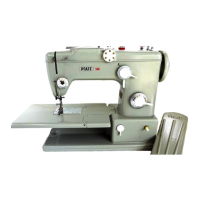Fig
. 3
Needle
System
130
R
(Needle
size, e. g.
No
. 80, 90
or
1()()_
given in hundredths
of
millimeters)
F = Flat side
of
shank
L
= Length
of
needle
St =
Needle
size (shaft diameter)
I =
long
groove
k =
Short
groove
H
=
Scarf
(cleoronce cut)
S = Point
0=
Eye
Fig. 4 Fig. 5
Fig.
6
Pfaff domestic sewing machines normally use System 130 R
needles
with flat
shank
and
scarf
(Fig.
4).
System 130 B round-shank needles
are
used for cord-
ing
and
two-needle fancy stitching.
Make
sure you use
only
"ORIGINAL
PFAFF
" needles (see a
ls
o
page
81
).
Needle
sizes
are
determined by
the
shaft
diameter
(St
in
Fig.
5)
and
ore
measured
in
hundredths
of
millimeters. A No. 100 needle,
for
example,
has
a
blade
diameter
of
100
/Joo,
or
one, millimeter.
Opposite
the flat side
of
the
shank, a long
groove
extends all
the
way down
to
the needle eye.
On
Pfaff zigzag
and
automatic sewing machines, this
groove
must face
toward
the
operator
always. The scarf,
or
clearance
cut,
marked H
in
Fig. 4 then faces
toward
the sewing hook.
The correct relationship between needle
and
thread size may
be
seen from the
Needle
and
Thread Chart
on
page
18.
The
Sewing
Hook
The functions
of
the sewing hook
are
(1)
to
enter
with its point
the
needle
thread
loop
which forms
at
the
needle
eye
as
the
needle ascends,
(2)
to
en-
large
this loop,
and
(3)
to
pass
it
around
the stationary bobbin
case
(Fig.
6).
'
There
are
different types
of
loop
takers,
the
most
popular
of
which
ore:
a. Shuttles
that
move
in
a race
and
are
driven by a shuttle driver, such
as
the
central-bobbin,
or
oscillating, shuttle d·epicted
in
Fig. 7,
and
b. Sewing hooks which
ore
carried
on
a
shaft
and
revolve freely.
8

